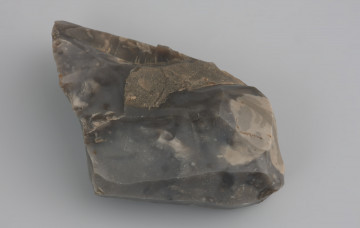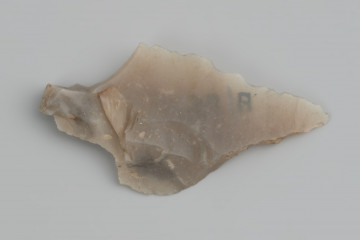
Single-stacked chipboard core
12700 p.n.e. — 11900 p.n.e.
National Museum in Szczecin
Part of the collection: Stone Age
A single-platform blade core from Tanowo, the Police district, was discovered during excavations in 1982 on a site containing material from different Palaeolithic and Mesolithic periods. It was made of chalk flint with a very high-quality method used by makers representing the Palaeolithic Hamburg culture. The method enables breaking off characteristic long and narrow chips with a soft pestle. The basic procedure guaranteeing obtaining such a half-product is the appropriate preparation of the impact plane, the so-called heel, which must be repaired as it is used. The treatment is called heel freshness and allows the proper shape of the core to be maintained. The core from Tanowo was used extensively, but the immediate cause of its abandonment was one too strong impact, which caused it to break into two pieces. The collection of flint wares from Tanowo, which included a single-platform core, contains tools and blades that are characteristic of the flint-work of the Hamburg culture people, despite the absence of arrowheads typical of that culture.
Michał Adamczyk
Author / creator
Dimensions
cały obiekt: height: 5.6 cm, width: 3 cm
Object type
production waste, lithic core
Technique
soft masher carving, hard masher carving, carving
Material
flint, stone
Origin / acquisition method
field research
Creation time / dating
Creation / finding place
Owner
National Museum in Szczecin
Identification number
Location / status

12700 p.n.e. — 11900 p.n.e.
National Museum in Szczecin

9600 p.n.e. — 9000 p.n.e.
National Museum in Szczecin

10800 p.n.e. — 9000 p.n.e.
National Museum in Szczecin
DISCOVER this TOPIC
National Museum in Lublin
DISCOVER this PATH
Educational path